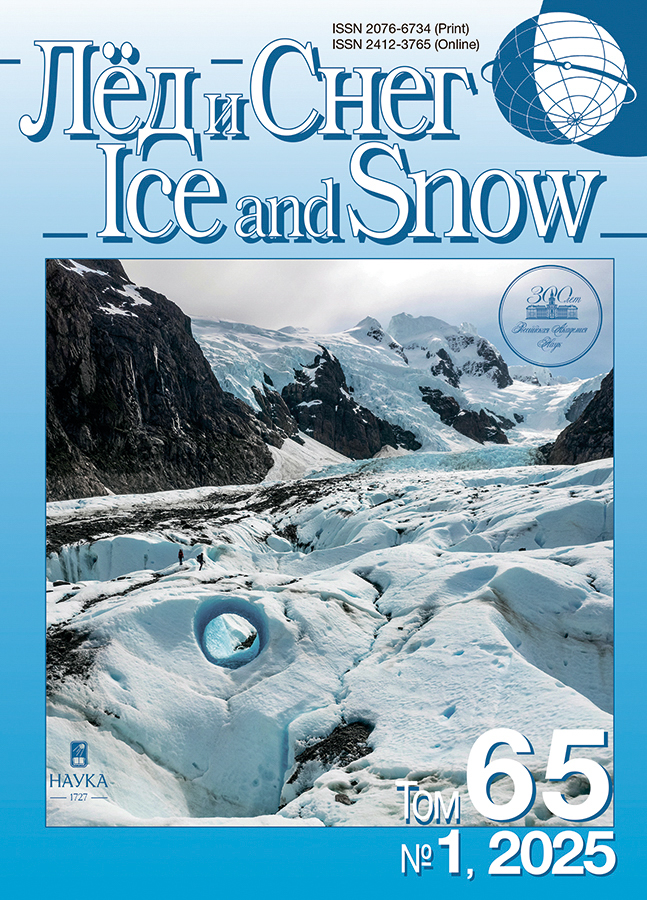Прорыв ледниково-подпрудного озера Спартаковское и изменения выводного ледника купола Семёнова–Тян-Шанского в 2021 г. (Северная Земля)
- Авторы: Муравьев А.Я.1, Чернов Р.А.1
-
Учреждения:
- Институт географии РАН
- Выпуск: Том 63, № 1 (2023)
- Страницы: 17-32
- Раздел: Ледники и ледниковые покровы
- URL: https://journals.rcsi.science/2076-6734/article/view/137460
- DOI: https://doi.org/10.31857/S2076673423010118
- EDN: https://elibrary.ru/MAINVD
- ID: 137460
Цитировать
Полный текст
Аннотация
Во второй половине августа 2021 г. на острове Большевик (Северная Земля) произошел прорыв ледниково-подпрудного озера Спартаковское. Объём спущенной из озера во фьорд Спартак воды составил около 376 ± 21 млн м3. Озёрная котловина наполнялась водой в 2016–2021 гг. существенно быстрее, чем в 2006–2016 гг. за счёт усиления поверхностной абляции на ледниках водосборного бассейна в условиях аномально теплого лета в 2018–2021 гг. Система “ледяная плотина–озеро” пришла к новому состоянию – сток в долину реки Базовая происходить более не может.
Ключевые слова
Об авторах
А. Я. Муравьев
Институт географии РАН
Автор, ответственный за переписку.
Email: anton-yar@rambler.ru
Россия, Москва
Р. А. Чернов
Институт географии РАН
Email: anton-yar@rambler.ru
Россия, Москва
Список литературы
- Атлас снежно-ледовых ресурсов мира. Т. 1. М.: Российская академия наук, 1997. 392 с.
- Барбаш В.Р., Говоруха Л.С., Зотиков И.А. О температурном состоянии толщи купола Вавилова // Тр. ААНИИ. 1981. Т. 367. С. 54–57.
- Большиянов Д.Ю., Макеев В.М. Архипелаг Северная Земля. Оледенение, история развития природной среды. СПб.: Гидрометеоиздат, 1995. 214 с.
- Большиянов Д.Ю., Соколов В.Т., Ежиков И.С., Булатов Р.К., Рачкова А.Н., Федоров Г.Б., Парамзин А.С. Условия питания и изменчивость ледников архипелага Северная Земля по результатам наблюдений 2014–2015 гг. // Лёд и Снег. 2016. Т. 56. № 3. С. 358–368. https://doi.org/10.15356/2076-6734-2016-3-358-368
- Брязгин Н.Н., Юнак Р.И. Температура воздуха и осадки на Северной Земле в периоды абляции и аккумуляции // Географические и гляциологические исследования в полярных странах. Л.: Гидрометеоиздат, 1988. С. 70–81.
- Василевич И.И., Чернов Р.А. К оценке снегозапасов в русловых врезах методом георадиолокации на территории Арктического региона // Проблемы Арктики и Антарктики. 2018. Т. 64. № 1. С. 5–15. https://doi.org/10.30758/0555-2648-2018-64-1-5-15
- Глазовский А.Ф., Мачерет Ю.Я. Вода в ледниках. Методы и результаты геофизических и дистанционных исследований. М.: ГЕОС, 2014. 528 с.
- Говоруха Л.С. Современное наземное оледенение Советской Арктики. Л.: Гидрометеоиздат, 1989. 256 с.
- Каталог ледников СССР. Т. 16. Вып. 1. Ч. 1. Л.: Гидрометеоиздат, 1980. 80 с.
- Кренке А.Н., Ходаков В.Г. О связи поверхностного таяния ледников с температурой воздуха // МГИ. 1966. Вып. 12. С. 153–164.
- Чернов Р.А., Муравьев А.Я. Природная катастрофа ледниково-подпрудного озера Спартаковское на о. Большевик (Северная Земля) // Криосфера Земли. 2020. Т. 24. № 4. С. 58–68. https://doi.org/10.21782/KZ1560-7496-2020-4(58-68)
- Чернов Р.А., Ромашова К.В. Современное состояние приледниковых озёр архипелага Шпицберген // Криосфера Земли. 2022. Т. 26. № 1. С. 36–45. https://doi.org/10.15372/KZ20220104
- Электронный архив ААНИИ срочных метеорологических и аэрологических наблюдений научно-исследовательского стационара “Ледовая база “Мыс Баранова” за 2013–2021 гг. // Электронный ресурс: http://old.aari.ru/main.php?lg=0&id=405. (Дата обращения 10.06.2022).
- Fan Y., Ke C., Shen X., Xiao Y., Livingstone S.J., Sole A.J. Subglacial lake activity beneath the ablation zone of the Greenland Ice Sheet // The Cryosphere Discuss. 2022. [preprint]. https://doi.org/10.5194/tc-2022-122
- Harrison S., Karge J.S., Hugge C., Reynolds J., Shugar D.H., Betts R.A., Emmer A., Glasser N., Haritashya U.K., Klimeš J., Reinhardt L., Schaub Y., Wiltshire A., Regmi D., Vilímek V. Climate change and the global pattern of moraine-dammed glacial lake outburst floods // The Cryosphere. 2018. V. 12. Is. 4. P. 1195–1209. https://doi.org/10.5194/tc-12-1195-2018
- Hugonnet R., McNabb R., Berthier E., Menounos B., Nuth C., Girod L., Farinotti D., Huss M., Dussaillant I., Brun F., Kääb A. Accelerated global glacier mass loss in the early twenty-first century // Nature. 2021a. V. 592. P. 726–731. https://doi.org/10.1038/s41586-021-03436-z
- Hugonnet R., McNabb R., Berthier E., Menounos B., Nuth C., Girod L., Farinotti D., Huss M., Dussaillant I., Brun F., Kääb A. Accelerated global glacier mass loss in the early twenty-first century – Dataset. 2021б. https://doi.org/10.6096/13
- Openaltimetry // Электронный ресурс. URL: https://openaltimetry.org/citation.html (Дата обращения: 12.09.2022).
- ECMWF Reanalysis v5 (ERA5) // Электронный ресурс. URL: https://www.ecmwf.int/en/forecasts/datasets/reanalysis-datasets/era5 (Дата обращения: 12.09.2022).
- pgc.umn.edu // Электронный ресурс. URL: https://www.pgc.umn.edu/data/arcticdem (Дата обращения: 12.09.2022).
- Liang Y., Bi H., Huang H., Lei R., Liang X., Cheng B., Wang Y. Contribution of warm and moist atmospheric flow to a record minimum July sea ice extent of the Arctic in 2020 // The Cryosphere. 2022. V. 16. Is. 3. P. 1107–1123. https://doi.org/10.5194/tc-16-1107-2022.
- Monthly Reanalysis Timeseries from Climate Reanalyzer. Climate Change Institute, University of Maine, USA // Электронный ресурс. https://climatereanalyzer.org/reanalysis/monthly_tseries/. (Дата обращения: 10.06.2022).
- Nie Y., Qiao L., Jida W., Zhang Y., Sheng Y., Liu S. An inventory of historical glacial lake outburst floods in the Himalayas based on remote sensing observations and geomorphological analysis // Geomorphology. 2018. V. 308. P. 91–106. https://doi.org/10.1016/j.geomorph.2018.02.002
- Porter C., Morin P., Howat I., Noh M.-J., Bates B., Peterman K., Keesey S., Schlenk M., Gardiner J., Tomko K., Willis M., Kelleher C., Cloutier M., Husby E., Foga S., Nakamura H., Platson M., Wethington M.Jr., Williamson C., Bauer G., Enos J., Arnold G., Kramer W., Becker P., Doshi A., D’Souza C., Cummens P., Laurier F., Bojesen M. // “ArcticDEM”. Harvard Dataverse. 2018. V. 1. https://doi.org/10.7910/DVN
- SENTINEL 2 Data Quality Report. ESA. Ref. S2-PDGS-MPC-DQR. 2022. Is. 71: 53 p. // Электронный ресурс. https://sentinel.esa.int/documents/247904/685211/Sentinel-2_L1C_Data_Quality_Report. (Дата обращения: 10.06.2022).
- Smith B., Adusumilli S., Csathy B.M., Felikson D., Fricker H.A., Gardner A., Holschuh N., Lee J., Nilsson J., Paolo F.S., Siegfried M.R., Sutterley T., and the ICESat-2 Science Team. 2021.
- ATLAS/ICESat-2 L3A Land Ice Height, Version 5. [Indicate subset used]. Boulder, Colorado USA. NASA National Snow and Ice Data Center Distributed Active Archive Center. https://doi.org/10.5067/ATLAS/ATL06.005
- Strozzi T., Wiesmann A., Kääb A., Joshi S., Mool P. Glacial lake mapping with very high resolution satellite SAR data // NHESS. 2012. V. 12. Is. 8. P. 2487–2498. https://doi.org/10.5194/nhess-12-2487-2012
Дополнительные файлы















